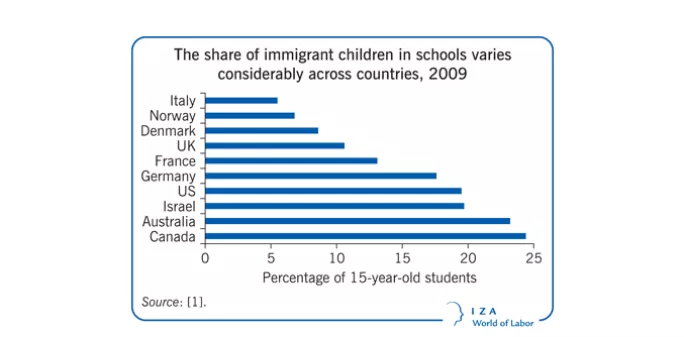A large number of migrant children in a school can lead to worse exam results in many countries, but not in England, according to research.
A new study shows that students in schools with a high proportion of migrant children can produce lower test scores in the US, Denmark, Israel, Italy and Norway. But in England pupils’ performance remains largely unaffected.
Researchers discovered that in England and the Netherlands a higher share of immigrant pupils in schools had no negative impact on the academic results of native children.
The report, from academics at Aarhus University in Denmark, says that in the majority of countries studied a higher share of migrants in classes led to reduced chances of passing exams and higher dropout rates from school.
[source: PISA database]
Although the study finds that the arrival of migrants does not necessarily have an impact on exam results, an overview of the studies in seven countries does warn that it can lead to what is known as “white flight”, where local families move out of an area.
The authors of the report state: “Many parents of native children are apparently so concerned about the impact of a high share of immigrant students on the quality of the learning environment that they move their children to a school with fewer immigrant children, which in many cases is a private school.
“In countries where no negative effects on the achievement of native students are found, these concerns are unjustified.”
The report suggests that migrant children from privileged backgrounds do not have a detrimental effect on native children, but disadvantaged migrants could have a negative impact.
“The effects might be remedied by improving immigrant children’s language acquisition and providing general support to all children from disadvantaged backgrounds,” the report says.
On the findings, Mary Bousted, general secretary of teaching union the ATL, said she was unsure why the negative impact occurred in other countries but stressed it did not happen in England.
“It’s interesting that in London high levels of immigration have raised the education standards overall. But in areas of low immigration, they are really struggling,” she told TES.
“In areas of high immigration, teachers become more expert at bringing a first-generation immigrant child on and helping them to succeed. The more practise you have the better you get at it.”
In their report, the authors conclude: “The empirical evidence on the effects of immigrant children on the performance of native children in the same school or classroom is mixed. It is not surprising that the results differ across countries, as it is highly unlikely that the effects of immigrant children in the classroom would be the same everywhere.
“Such effects will obviously depend on the organisation of the education system as well as the characteristics of the immigrant population. Education systems are organised differently across countries, and different countries attract different categories of immigrants.”
Read the study here: http://bit.ly/1GAO8Yi
Want to keep up with the latest education news and opinion? Follow TES on Twitter and like TES on Facebook





